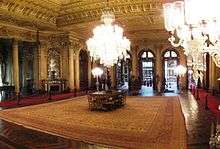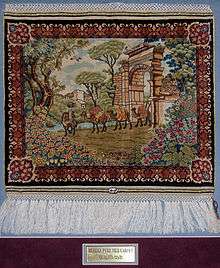Hereke carpet


0.6 m2, 32 x 32 knots/cm2; 13 years of work
Hereke carpets are only produced in Hereke, a coastal town in Turkey, 60 km from Istanbul. The materials used are silk, a combination of wool and cotton and sometimes gold or silver threads.
The Ottoman sultan, Abdülmecid I founded the Hereke Imperial Manufacture in 1841 to produce all the textiles for his Dolmabahçe Palace on the Bosphorus. He gathered the best artists and carpet weavers of the former Ottoman Empire in Hereke, where they began producing high quality rugs and large carpets with unique patterns.
After completing work on the Dolmabahçe Palace, the Ottoman sultans used to give Hereke carpets as gifts to selected visiting royalties, noblemen and statesmen. It was not until 1890 that some traders in Istanbul were allowed to sell some of the pieces made at Hereke. With the end of the Ottoman Empire the production of Hereke carpets was restricted until the middle of the 20th century when some master-weavers in Hereke began once more to produce the carpets in continuation of the tradition of the Ottoman palace carpets.
As of 1920, Hereke was home to a carpet making school which was run by the state. Both Muslim and Christian women and children attended classes.[1]
Hereke carpets typically are very large, palace sized carpets, and are made with wool on cotton, camel hair on cotton, silk on cotton as well as silk on silk, which are knotted in small sizes. The precision of their double knots (Turkish or Ghiordes knots), which allows the clear display of patterns, together with the colour combinations and the harmonious patterns have made them highly collectible. Today, Hereke carpets and rugs are still made with the traditional patterns of the Ottoman sultan, Abdülmecid I, as well as both traditional Anatolian and contemporary figurative patterns.
Literature
- M. Kenan Kaya, Yaşar Yılmaz, Sara Boynak, Vahide Gezgör. Hereke Silk Carpets and Fabrics in the National Palaces Collection. TBMM, Istanbul.
- Oktay Aslanapa, Ayşe Fazlıoğlu. The Last Loop of the Knot; Ottoman Court Carpets. TBMM, Istanbul, 2006.
- Uğur Ayyıldız. Hereke and Kayseri: Pure silk Turkish carpets. NET Turizm Ticaret ve Sanayi A.S (1983). ASIN B0007B1NHG
- Önder Küçükerman. The rugs and textiles of Hereke: A documentary account of the history of Hereke : court workshop to model factory. Sümerbank Genel Müdürlüğü (1987). ASIN B0007BYPCQ
References
External links
![]() Media related to Hereke carpets at Wikimedia Commons
Media related to Hereke carpets at Wikimedia Commons